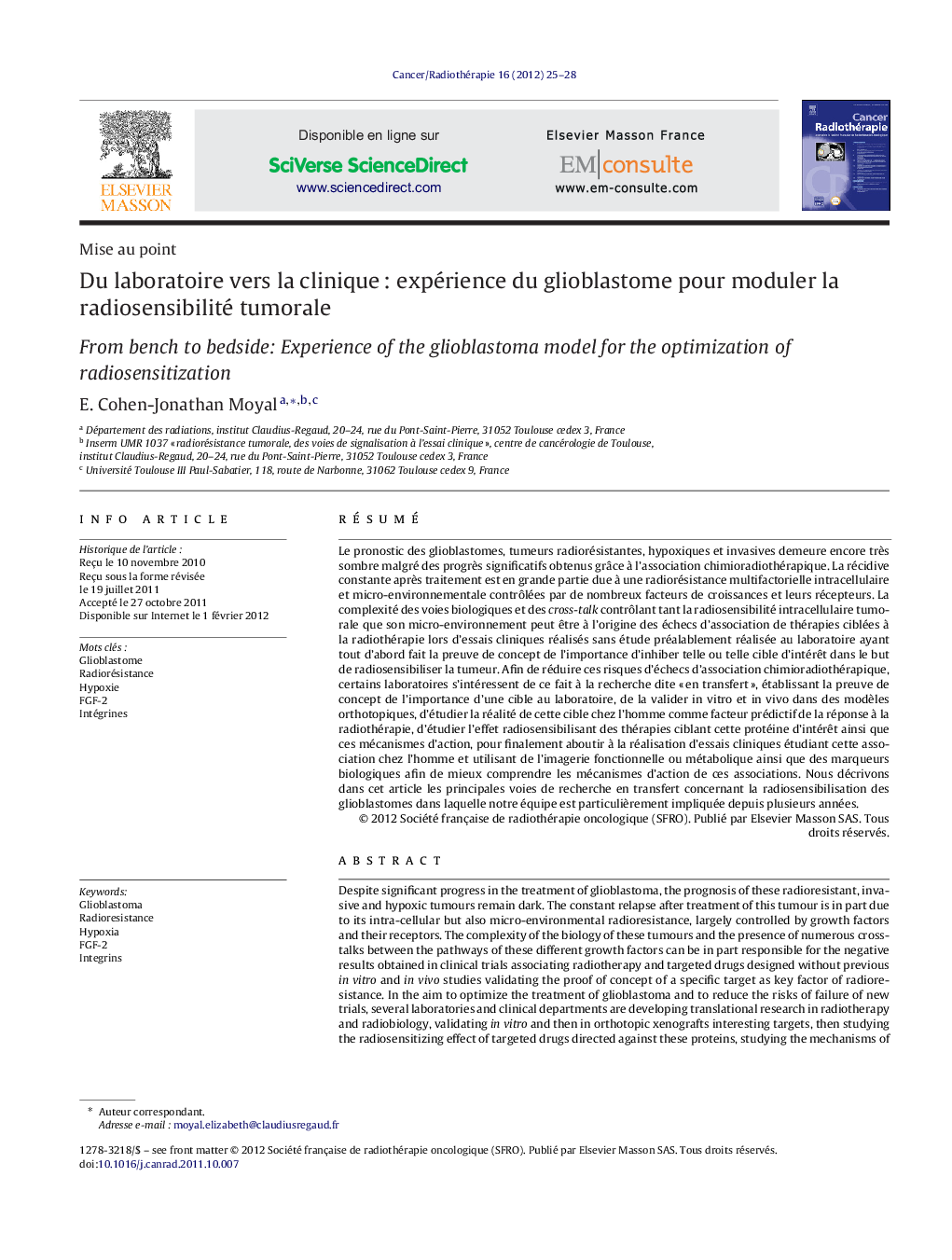| کد مقاله | کد نشریه | سال انتشار | مقاله انگلیسی | نسخه تمام متن |
|---|---|---|---|---|
| 2118314 | 1085230 | 2012 | 4 صفحه PDF | دانلود رایگان |

RésuméLe pronostic des glioblastomes, tumeurs radiorésistantes, hypoxiques et invasives demeure encore très sombre malgré des progrès significatifs obtenus grâce à l’association chimioradiothérapique. La récidive constante après traitement est en grande partie due à une radiorésistance multifactorielle intracellulaire et micro-environnementale contrôlées par de nombreux facteurs de croissances et leurs récepteurs. La complexité des voies biologiques et des cross-talk contrôlant tant la radiosensibilité intracellulaire tumorale que son micro-environnement peut être à l’origine des échecs d’association de thérapies ciblées à la radiothérapie lors d’essais cliniques réalisés sans étude préalablement réalisée au laboratoire ayant tout d’abord fait la preuve de concept de l’importance d’inhiber telle ou telle cible d’intérêt dans le but de radiosensibiliser la tumeur. Afin de réduire ces risques d’échecs d’association chimioradiothérapique, certains laboratoires s’intéressent de ce fait à la recherche dite « en transfert », établissant la preuve de concept de l’importance d’une cible au laboratoire, de la valider in vitro et in vivo dans des modèles orthotopiques, d’étudier la réalité de cette cible chez l’homme comme facteur prédictif de la réponse à la radiothérapie, d’étudier l’effet radiosensibilisant des thérapies ciblant cette protéine d’intérêt ainsi que ces mécanismes d’action, pour finalement aboutir à la réalisation d’essais cliniques étudiant cette association chez l’homme et utilisant de l’imagerie fonctionnelle ou métabolique ainsi que des marqueurs biologiques afin de mieux comprendre les mécanismes d’action de ces associations. Nous décrivons dans cet article les principales voies de recherche en transfert concernant la radiosensibilisation des glioblastomes dans laquelle notre équipe est particulièrement impliquée depuis plusieurs années.
Despite significant progress in the treatment of glioblastoma, the prognosis of these radioresistant, invasive and hypoxic tumours remain dark. The constant relapse after treatment of this tumour is in part due to its intra-cellular but also micro-environmental radioresistance, largely controlled by growth factors and their receptors. The complexity of the biology of these tumours and the presence of numerous cross-talks between the pathways of these different growth factors can be in part responsible for the negative results obtained in clinical trials associating radiotherapy and targeted drugs designed without previous in vitro and in vivo studies validating the proof of concept of a specific target as key factor of radioresistance. In the aim to optimize the treatment of glioblastoma and to reduce the risks of failure of new trials, several laboratories and clinical departments are developing translational research in radiotherapy and radiobiology, validating in vitro and then in orthotopic xenografts interesting targets, then studying the radiosensitizing effect of targeted drugs directed against these proteins, studying the mechanisms of action and resistance of these drugs, validating these proteins as predictive factors of response to radiotherapy in the patients, and then designing clinical trials, integrating metabolic or functional imaging and surrogate markers to better understand the mechanism of action of these associations. We describe in this article the main translational research axis developed for radiosensitizing glioblastoma, which our lab and department have pursued for several years.
Journal: Cancer/Radiothérapie - Volume 16, Issue 1, February 2012, Pages 25–28